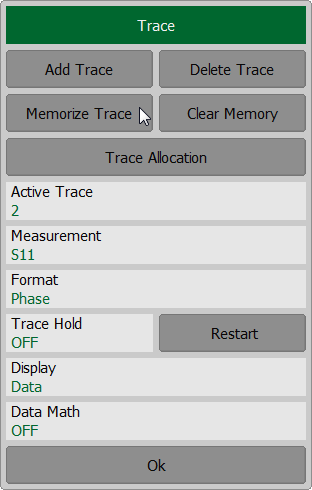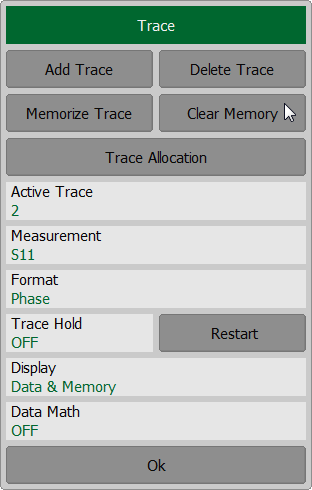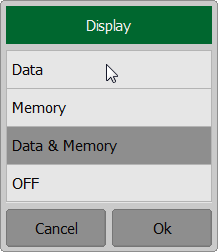An associated memory trace can be created for each data trace. The memory trace is saved at the moment when the corresponding softkey is pressed or a program command is received. After saving the memory trace, the screen displays two traces — data and memory. The following settings of the memory and traces display can be performed:
Display |
Trace status field |
|---|---|
Data and memory |
|
Memory only |
|
Data only |
|
Data and memory OFF |
|
The memory trace is displayed in the same color as the main data trace, but it is half as bright (color and brightness of data and memory traces can be customized, see User Interface Setting).
The memory trace is used for displaying and mathematical operations with data trace. For a detail description see Mathematical Operations.
The memory trace has the following features of the data trace:
•frequency range
•number of points
•sweep type
The memory trace has the following settings common with the data trace (which if changed, modifies both traces):
•format
•scale
•smoothing
•electrical delay
The following data trace settings (if changed after the memory trace creation) do not influence the memory trace:
•power in frequency sweep mode
•IF bandwidth
•averaging
•calibration
Saving Data Trace into Memory
The function of saving data traces into memory is applied to an individual trace.
The trace to which the function is applied must be preselected as active (See Selection of Active Trace).
Click the Trace softkey on right menu bar. If necessary, select the required trace by clicking on Active Trace field. To save trace into memory, click on the Memorize Trace softkey. The data will be saved into memory immediately.
|
Erasing Memory
The trace to which the function is applied must be preselected as active (See Selection of Active Trace).
Click the Trace softkey on right menu bar. If necessary, select the required trace by clicking on Active Trace field. To erase the memory of the trace, click on the Clear Trace softkey.
|
Trace Display Setting
The trace to which the function is applied must be preselected as active (See Selection of Active Trace).
Click the Trace softkey on right menu bar. If necessary, select the required trace by clicking on Active Trace field. To set the type of traces to be displayed on the screen, click on the Display field and select the required type from the list.
|








